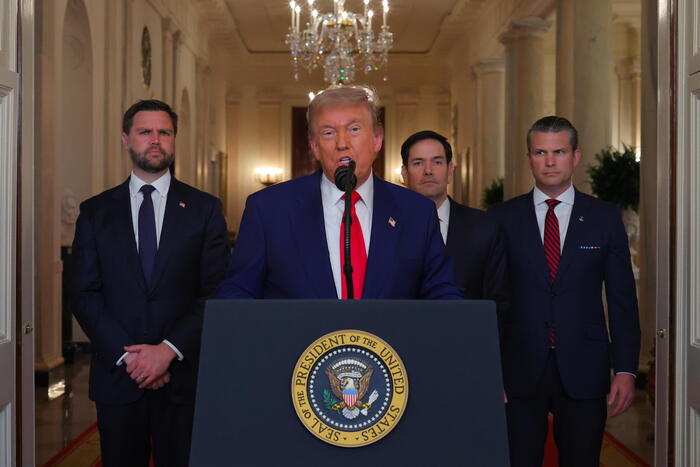The United States has officially entered the conflict between Israel and Iran. On Saturday evening, President Donald Trump announced that the U.S. Air Force had conducted a strike on three Iranian nuclear sites, including the underground facility at Fordow, marking the first direct military intervention against Iranian nuclear infrastructure since 1979.
“A full load of bombs was dropped on Fordow. All aircraft are now out of Iranian airspace and returning safely,” Trump wrote on Truth Social, claiming the mission had been successfully completed.
Shortly after, the president spoke live from the White House, flanked by Vice President J.D. Vance, Secretary of State Marco Rubio, and Secretary of Defense Pete Hegseth. In a nationally broadcast address, Trump declared: “Everybody heard those names for years as they built this horrible destructive enterprise. Our objective was the destruction of Iran’s nuclear enrichment facility,” said Trump on Saturday night. “The strikes were a spectacular military success”.
“Iran “must now make peace” and that “if they do not, future attacks will be far greater and a lot easier” he warned. “There will be either peace or there will be tragedy for Iran,” he said, “Remember, there are many targets left. Tonight was the most difficult of them all by far, and perhaps the most lethal.”
The White House confirmed that Trump spoke by phone with Israeli Prime Minister Benjamin Netanyahu both before and after the attack. Congressional leaders had also been briefed on the impending military action.
Just 24 hours earlier, Trump had said he would decide within two weeks whether or not to join Israel’s offensive against Iran. Instead, he acted early, ordering a preemptive strike that the administration justifies as a measure to block a potential Iranian “final sprint” toward a nuclear weapon.
According to Pentagon sources, several B-2 bombers took off from Whiteman Air Force Base in Missouri, armed with 15-ton bunker-buster bombs designed to penetrate fortified installations like Fordow, which is buried under hundreds of meters of rock. Some aircraft are now en route to Guam, but no further strikes have been confirmed at this time.
Following the raid in Iran, the Pentagon raised the alert level at all U.S. military installations worldwide. Bases in the Middle East, Europe, Asia, and the Pacific were placed on “Threat Condition Delta,” the highest security level reserved for imminent threats. Defense Department sources reported that the order was issued out of concern for possible Iranian retaliation or coordinated attacks by allied groups such as Hezbollah, Shiite militias in Iraq, or the Houthi rebels in Yemen. U.S. embassies in various capitals have also been reinforced, while American forces in Japan, South Korea, Bahrain, Qatar, and Germany have received instructions to operate in a state of permanent readiness.
Iran responded firmly. President Masoud Pezeshkian reiterated that Tehran “will not under any circumstances” abandon its nuclear program, while also declaring itself “ready for dialogue.” In the meantime, he confirmed the intention to continue military reprisals against Israel.
Ahead of the American intervention, the Israeli air force had struck strategic targets in southern Iran. Tehran responded by launching missiles and drones at Israeli targets. Israel announced the killing of three senior Quds Force commanders: Mohammed Said Izadi, Behnam Shahriyari, and Aminpour Joudaki. Iran has not yet officially confirmed the deaths.
Amid the growing chaos, the State Department has begun evacuating U.S. citizens from Israel and the West Bank. The U.S. ambassador in Jerusalem, Mike Huckabee, urged Americans to register for departure via charter flights, cruise ships, or government aircraft.
Two Israeli officials told CNN that they expect prolonged U.S. involvement in the war. This assessment is shared by several intelligence agencies, which have observed increased naval movement in the eastern Mediterranean and heavy air traffic from bases in England and the Gulf.
Speaker of the House Mike Johnson defended the operation, stating on X that the action “shows that President Trump means business. He gave the Iranian regime every opportunity to negotiate, but they refused to cooperate.”
Senate Majority Leader John Thune also expressed support: “We are acting to ensure Iran never obtains a nuclear weapon. I am praying for our military personnel involved.”
However, criticism was not lacking. Hakeem Jeffries, the top Democrat in the House, said Trump had “misled” Americans. “The risk of war has now dramatically increased, and I pray for the safety of our troops in the region who have been put in harm’s way,” he said in a statement.
Trump’s decision marks a watershed moment not only for U.S. foreign policy but also for the complex balance of power in the Middle East. After years of “America First” rhetoric and promises of disengagement, the commander-in-chief now finds himself involved in a war that risks expanding and engulfing the entire region.
The coming hours will be critical in determining whether this was a limited action or the beginning of a new chapter of American military presence in the Middle East—a chapter that, as in the past, may also reshape domestic political dynamics in the United States.












